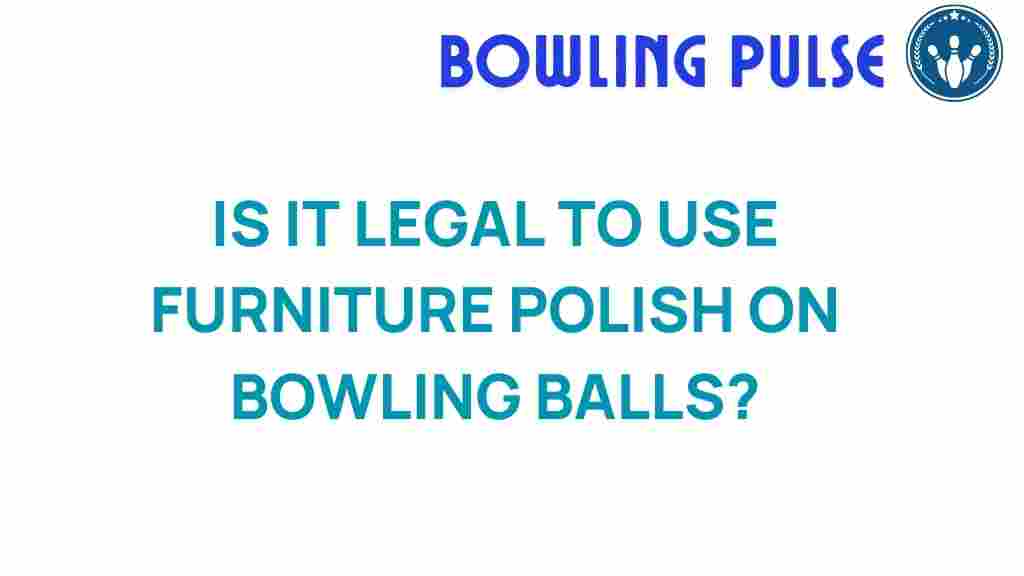The Surprising Truth: Is Furniture Polish Safe for Bowling Balls?
Maintaining sports gear is essential for optimal performance, and bowling balls are no exception. With the plethora of cleaning products available, bowlers often wonder whether using furniture polish is a safe and effective method for keeping their bowling balls in top condition. In this article, we will explore the relationship between furniture polish and bowling balls, discuss maintenance techniques, and provide you with the knowledge to make informed decisions regarding the safety and effectiveness of your cleaning routine.
Understanding Bowling Ball Materials
Before delving into the cleaning methods, it’s vital to understand the materials that comprise bowling balls. Bowling balls are typically made from three types of materials:
- Plastic: Ideal for beginners; they are durable and less expensive.
- Urethane: Offers a better grip and is used by intermediate players.
- Reactive Resin: Preferred by advanced bowlers for its superior hook potential.
Each type of material has different care requirements, which is why knowing what you’re cleaning is crucial.
What is Furniture Polish?
Furniture polish is a cleaning product designed to enhance the appearance of wooden furniture. It often contains oils, waxes, and solvents that help to clean, shine, and protect surfaces. While it serves its purpose well on wood, the question arises: Can it be used safely on bowling balls?
Is Furniture Polish Safe for Bowling Balls?
The short answer is: it depends. While some types of furniture polish may seem harmless, there are several factors to consider when using them on bowling balls. Here’s what you need to know:
Potential Risks of Using Furniture Polish
- Residue Build-Up: Many furniture polishes leave a waxy residue, which can affect the ball’s surface texture and performance.
- Compromised Grip: The oils and waxes can make the surface slick, leading to decreased control during play.
- Chemical Reactions: Certain components in furniture polish can react negatively with the materials used in bowling balls, potentially damaging them over time.
Given these risks, it is generally not advisable to use furniture polish on your bowling balls. However, if you’re considering it for maintenance, it’s essential to proceed with caution.
Recommended Maintenance Techniques for Bowling Balls
To ensure the longevity and performance of your bowling balls, consider the following maintenance techniques:
- Regular Cleaning: Use a microfiber cloth and specialized bowling ball cleaner after each session to remove oil and dirt.
- Deep Cleaning: Every few months, soak your ball in lukewarm water mixed with a few drops of dish soap for 15-30 minutes, then rinse and dry thoroughly.
- Surface Maintenance: Use a surface scuff pad to gently restore the texture of the bowling ball if it feels slick.
- Storage: Store your bowling ball in a cool, dry place away from direct sunlight and extreme temperatures.
Choosing the Right Cleaning Products
When it comes to cleaning your bowling balls, it’s crucial to choose products specifically designed for them. Here are some recommended cleaning products:
- Bowling Ball Cleaner: These are formulated to remove oil and dirt without harming the ball’s surface.
- All-Purpose Cleaners: Ensure they are safe for use on synthetic surfaces.
- Microfiber Cloths: Ideal for wiping down the ball without scratching it.
Always check the labels of cleaning products before use to ensure they won’t damage your ball.
Step-by-Step Cleaning Process for Bowling Balls
Here’s a simple step-by-step guide to cleaning your bowling ball effectively:
- Gather Supplies: Collect a microfiber cloth, bowling ball cleaner, and a soft brush or sponge.
- Inspect the Ball: Examine the surface for any scratches or scuffs.
- Apply Cleaner: Spray or apply the bowling ball cleaner to your microfiber cloth, not directly on the ball.
- Wipe Down: Gently wipe the surface of the ball in circular motions, focusing on any areas with dirt or oil buildup.
- Rinse (if needed): If using soap and water, rinse thoroughly with clean water.
- Dry the Ball: Use a clean, dry microfiber cloth to wipe the ball completely.
- Store Properly: Place the ball in its bag or stand, ensuring it’s protected from dust and scratches.
Troubleshooting Common Issues
Even with proper maintenance, you may encounter some issues with your bowling ball. Here are some troubleshooting tips:
- Ball Feels Slippery: This may be due to residue. Clean the surface with a specialized bowling ball cleaner.
- Loss of Hook: This can indicate a buildup of oil. A deep clean may be necessary.
- Visible Damage: If you notice cracks or deep scratches, consult a professional for repair rather than attempting to fix it yourself.
Conclusion: Prioritize Safety and Performance
In summary, while furniture polish may seem like an easy cleaning solution for your bowling ball, it poses several risks that can compromise both the safety of your gear and your performance on the lanes. Instead, focus on using cleaning products specifically designed for bowling balls and follow proper maintenance techniques to ensure your equipment remains in peak condition.
By prioritizing the right cleaning methods and products, you can enhance your bowling experience and extend the life of your sports gear. Remember, investing time in maintenance is an investment in your performance!
For more tips on sports gear maintenance, check out this comprehensive guide on keeping your equipment in top shape!
For more information on the best cleaning products for various sports gear, visit this resource page.
This article is in the category Techniques and created by BowlingPulse Team
